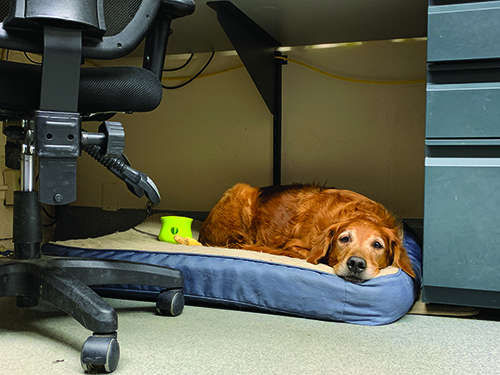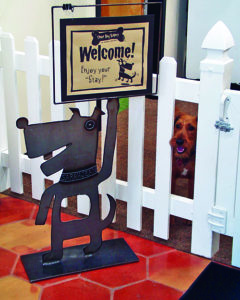
As the saying goes, “Life is better when I’m with my dog.” I can cite a long list of ways that he makes my days brighter – even my work days! From petting his soft fur or listening to his quiet snoring, to how he makes me laugh as he playfully brandishes his toys in hopes of a game of tug and getting me away from and computer every few hours for a walk around the block. See, I’m lucky. My dog Saber accompanies me to the office several days each week at the guide dog school where I oversee the puppy-raising program.
The Human Animal Bond Research Institute reports pets in the workplace can make employers more attractive to prospective employees, increase employee engagement and retention, improve relationships between employees and supervisors, and lower absenteeism. There’s also potential health benefits: stress management, a calming effect, and often an improvement in work-life balance.
It’s definitely nice to reach down and scratch my dog’s ears when I’m feeling overwhelmed with project deadlines. Stepping outside into the designated employee pet play yard helps ensure I don’t sit at my desk and work through lunch every day. Sometimes we spend my break walking around the block. Mostly, as an apartment dweller, I appreciate knowing he’s not stuck inside at home when I’m working long days. It’s a very nice job perk.
Despite the reported advantages, the Society for Human Resource Management reports less than 10 percent of U.S. employers welcome personal pets in the workplace on a regular basis.
While the benefits are notable, pets (for the purposes of this article, we’ll limit our thoughts to dogs, specifically) in the workplace can be tricky. Some office cultures might support an anything-goes mentality where people don’t bat an eye at a rambunctious indoor dog park unfolding in the lobby. However, the attitude of “love me, love my dog” does not generally bode well for harmonious happenings during the daily grind. Bringing personal pets to the workplace, especially an office environment, is a privilege that might be more widely considered by employers if they felt it was less likely to be disruptive.
If you’re hoping to lobby for Fido to join you at work, or your company is considering implementing a pets-at-work policy, consider the following:
1. ESTABLISH BASIC HEALTH AND BEHAVIOR GUIDELINES. It should go without saying workplace dogs should be disease- and parasite-free, clean and well-groomed, and appropriately vaccinated.
[post-sticky note-id=’442905′]In the office, the priority should be healthy workplace productivity. Ill-behaved dogs can be a nuisance almost anywhere, but the stakes are much higher when we’re at work. To keep everyone safe, at a minimum, potential canine colleagues should be of sound temperament, well-socialized to people, and should not have a history of aggressive behavior or biting. Excessive barking, jumping up on people, getting into the trash, marking or repeated housetraining accidents, and inappropriate chewing are all behaviors that should not be tolerated in the workplace.
While the definition of “well-trained” will always be subjective, requiring office-candidate dogs to successfully pass the American Kennel Club’s Canine Good Citizen (CGC) test is one way to set a minimum behavior standard. Even better, ask employees to attain the mid-level Community Canine title, a similar, 10-part evaluation, but with elements performed in real-life settings such as busy sidewalks or local parks rather than a training facility.
Attaining these titles requires owners to invest time in training their dogs, and trained dogs are much more likely to be comfortable and behave appropriately in different settings. Plus, owners who participate in dog training programs are more likely to understand dog behavior and dog body language, and are therefore likely better equipped to prevent or address challenges that might arise when bringing their dogs to work.
2.MANAGEMENT MATTERS. It’s always important to set dogs up for success. This is especially true when asking them to cohabitate with colleagues who might not be used to sharing their space with dogs. In our opinion, letting office dogs “free range” throughout the office is a recipe for trouble, as it’s impossible to interrupt or redirect your dog’s unwanted behavior when you have no idea where he is or what he’s doing.

Employees with a private office can use a baby gate in the doorway to keep their dogs from cruising the halls without them. If the workplace set-up and dog’s level of training allows, a crate, x-pen or chew-proof tether can be used when owners are unable to supervise the dog, or when the dog needs a little imposed down-time. Make sure the dog has a cozy bed, and use favorite chew items or food puzzles to encourage the dog to spend time on his bed. An office dog doesn’t need to be on-the-go all the time. Dogs home alone spend much of their day quietly lounging; dogs at work can, too.
3. TAKE PROACTIVE RESPONSIBILITY FOR YOUR DOG. “Love me, love my dog” might fly when seeking a life-partner, but it’s a selfish mentality when sharing workspace with others. If you’re lucky enough to be granted permission to bring your dog to work, go the extra mile to make sure your dog is never a nuisance to others.
Respect colleagues’ wishes to decline interaction. Some people are afraid of dogs. Some cultures view dogs as “dirty” animals that should strictly live outside. Some people live with varying degrees of dog-related allergies. And some people are just “cat people” or otherwise choose to be pet-free. Be sensitive and respectful to these differences. Personally, I like to aim for the standard of a well-trained service dog in a restaurant, that is, for most people to not even realize the dog is there, because it’s quietly tucked at its handler’s feet.
That’s not to say office dogs should never been seen or heard, but in an age where fake service dogs are rampant and many dog owners feel entitled to regularly bring questionably or clearly untrained dogs into otherwise non-pet-friendly establishments, it’s more important than ever for responsible dog owners to go the extra mile to show how welcoming dogs need not become problematic for others.
Keep your dog well-groomed to reduce shedding. Have lint rollers and hand sanitizer handy for any colleagues or visitors who might welcome interaction but are surprised by the “magical fibers of love” now clinging to their pants or who might want to clean their hands. Immediately address barking or rambunctious play, especially when colleagues are within earshot and on the phone, in a meeting, or on a deadline. If your dog is overly solicitous of attention from others, direct him to “go lie down,” so colleagues can work in peace (see “Useful Matters,” WDJ January 2020, for tips on teaching your dog to be happy on his mat.) In general, be considerate of others.

Give your dog ample opportunities to relieve in approved areas and clean up after him. Keep cleaning products on hand for unexpected accidents or moments of illness. Leave the toy with the 16 squeakers and the animal-product chew stick – the one that smells like warm death when soggy after a good chewing – at home.
And whatever you do, if your dog ever happens to counter-surf someone’s unattended lunch from their desk, immediately offer to replace it, no excuses! (Years ago, my first dog, a Whippet with a weakness for all things “carbs” might’ve given me an opportunity or two to practice this last tip.)
[post-sticky note-id=’442907′]4. REMEMBER, IT’S AN OFFICE, NOT A DOG PARK. Many people enjoy sharing their lives with multiple dogs, but when it comes to dogs in the workplace, there can easily be too much of a good thing. If you have more than one dog, consider rotating which dog accompanies you to the office each day. Even where I work, at a dog-related organization, where everyone’s workspace has been designed to safely manage dogs, and half of the dog-owning employees are trainers, staff are limited to bringing only two personal dogs to work each day.
5. ADVOCATE FOR YOUR DOG. Not all dogs are good candidates for the workplace, even if they aren’t outwardly aggressive. Shy or fearful dogs might prefer the stability of staying home versus the sometimes unpredictable nature of the workplace and its accompanying sense of “stranger danger.” If your dog gets car sick, he might not appreciate starting and ending each day in the car. If your dog is generally indifferent to other dogs, he might not enjoy sharing relatively close quarters with your cubicle-mate’s social butterfly of a Labrador.
It’s important to carefully consider your dog’s temperament and overall personality. Maybe he’s not right for the workplace at all. Or maybe it’s best to limit office visits to a couple of days each week.
Even if your dog is perfectly suited for life in the office, it’s still important to set some boundaries. If colleagues have the opportunity to interact with your dog, don’t be afraid to request that they follow certain rules. They might not care if your dog jumps on them, but if you care, insist they ask your dog to sit before petting. They might want to shower your dog with Scooby Snacks all throughout the day. If that doesn’t work for you, don’t be afraid to set some guidelines. Be nice about it, but it’s perfectly okay to ask that your ground rules be followed.
BE PROACTIVE
Welcoming dogs into the workplace can be a great way to boost employee morale, but it’s not without its challenges, and it’s not right for every organization. Careful planning and clear expectations can go a long way in setting up people – and their pets – for success when implementing a canine colleague policy.
Related Article
Dogs in the Workplace Company Profile: On-Site LaserMedic






I’d never get any work done — I’d want to play with all the dogs!
I love any workplace that let dog come in.
Good Tips! Looking forward to being able to use them soon….